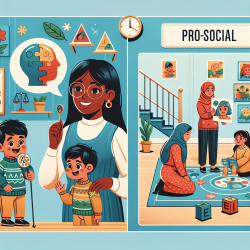As practitioners dedicated to improving the lives of children with Autism Spectrum Disorder (ASD), it is essential to stay updated with the latest research and interventions. One such promising intervention is the Tübinger Training for Autism Spectrum Disorders (TüTASS). This structured group intervention focuses on enhancing self-perception and social skills in children with ASD through a combination of mindfulness and body awareness exercises.
According to the study "Tübinger Training for Autism Spectrum Disorders (TüTASS): a structured group intervention on self-perception and social skills of children with autism spectrum disorder (ASD)," TüTASS includes 20 sessions of 90 minutes each. These sessions cover basic skills such as emotions, body awareness, and communication, which are then applied to personal, family, peer, and school settings. The intervention showed significant improvements in behaviors associated with autism, as well as in externalizing and internalizing behaviors, based on parent reports, participant self-reports, and independent assessments.
Key outcomes from the TüTASS study include:
- Improved social communication and motivation
- Decreased externalizing behaviors such as rule-breaking and aggression
- Enhanced emotion regulation and self-control
- Reduced perceived parental burden
- Increased self-rated quality of life among participants
These findings are crucial for practitioners looking to implement evidence-based interventions. Here are some actionable steps you can take to incorporate the principles of TüTASS into your practice:
1. Emphasize Mindfulness and Body Awareness
Mindfulness exercises, such as body scans and progressive muscle relaxation, can help children with ASD become more aware of their emotions and bodily sensations. Incorporate these exercises into your sessions to help children manage stress and improve focus.
2. Focus on Emotion Recognition and Regulation
Use role-playing and pantomime activities to help children recognize and understand different emotions. Teach strategies for coping with strong emotions, such as anger, to reduce the likelihood of behavioral outbursts.
3. Enhance Communication Skills
Address both non-verbal and verbal communication skills. Practice recognizing gestures, facial expressions, and tone of voice. Encourage children to engage in small talk and other everyday communication scenarios to build their confidence and social competence.
4. Foster Social Interaction and Friendships
Create opportunities for children to interact in a supportive group setting. Activities that promote teamwork and mutual respect can help children form meaningful friendships and improve their social skills.
5. Involve Parents and Caregivers
Offer sessions for parents to educate them about ASD and provide strategies for supporting their children at home. Parental involvement is crucial for reinforcing the skills learned during the intervention.
By incorporating these strategies into your practice, you can help children with ASD develop the social and emotional skills they need to thrive. The TüTASS intervention has shown promising results, and further research can help refine and expand its application.
To read the original research paper, please follow this link: Tübinger Training for Autism Spectrum Disorders (TüTASS): a structured group intervention on self-perception and social skills of children with autism spectrum disorder (ASD).










